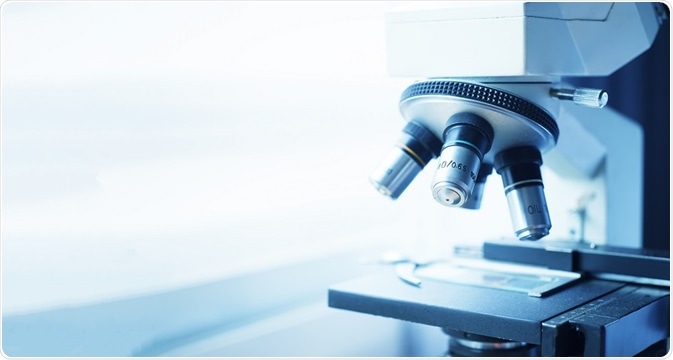By Gillian D’Souza, MSc
Immunoenzymatic chromogen staining is an immunology staining technique used to visually detect two or more antigenic markers within a single tissue sample (colocalization).
 Credit: Have a nice day photo/Shutterstock.com
Credit: Have a nice day photo/Shutterstock.com
With the help of chromogens, researchers use this technique to observe antigens of interest in a biological sample under bright field microscopy. Immunoenzymatic chromogen staining has a number of advantages, especially when compared to immunofluorescence.
Clear identification of cells
When dealing with many antibodies, it is sometimes difficult to differentiate between positive and negative cells. For instance, while observing positive nuclei with the proliferation marker Ki67, one cannot clearly ascertain which cell type is actually proliferating.
In a double-staining experiment (such as immunoenzymatic staining), the antibody of interest is mixed with an antibody against a structural marker to detect epithelial cell types, lymphocytes, granulocytes, eosinophils, macrophages, endothelial cells and nerve cells, among others.
For newly developed antibodies, it becomes vital to know which cell type is the main target and if the cells’ biological data fit with the suspected tissue localization. This is where double staining with immunoenzymatic staining assumes great importance.
Better understanding of cell behavior
Multicolor immunoenzymatic chromogen staining allows researchers to visually identify specific cell types/populations or determine cell derivation. It enables identification of specific processes happening within those cells – in well-preserved, whole tissue specimens of various states.
When multiple staining techniques (with up to four different markers) are effectively combined with spectral imaging analysis, avenues into understanding complex relationships in and between various cellular processes can be opened.
Combine and compare made easy
Combining immunoenzymatic staining with other biochemical tests allows a direct comparison of antigenic markers across different parameters. For example, when combined with DNA for in situ hybridization, researchers can gain insight into the cellular phenotype of viral-infected cells. Similarly, combining immunoenzymatic staining with RNA factor in situ hybridization allows for comparison of a particular antigen at both mRNA and protein levels in a single tissue section.
Limited use of tissue sample
In situations where a limited number of tissue specimens are available for histology and assay experiments, multiple staining allows the study of more markers within a single sample – this saves on resources to a great degree.
Ease of observation
Immunoenzymatic chromogen staining not only allows for easy microscopic observation with the unaided eye, but also ensures that the stained tissue section is permanently fixed, with its staining quality maintained for several years.
Unlike immunofluorescence the chromogens used in immunoenzymatic staining can be viewed simultaneously at the completion of the assay, using standard light microscopy. Moreover, they can be viewed repeatedly without altering staining results. These benefits offer significant value to researchers, especially in the early phases of a study.
The introduction of spectral imaging promises to take immunoenzymatic staining techniques to the next level, possibly offering opportunities for multi-marker tissue analysis. Spectral unmixing has potential to demonstrate colocalization as an exclusive image, in addition to further analyzing and quantitating the unmixed component images from triple or even quadruple IHC-stained tissue samples.
Further Reading
Last Updated: Feb 26, 2019